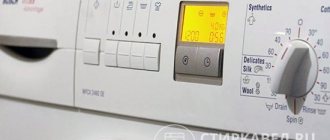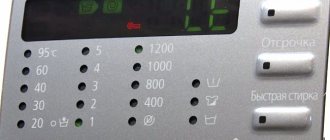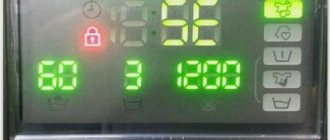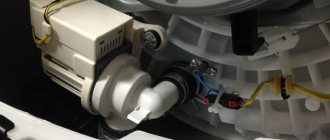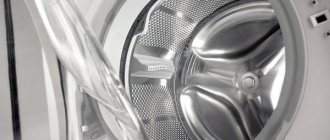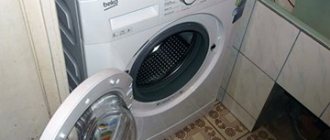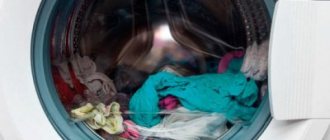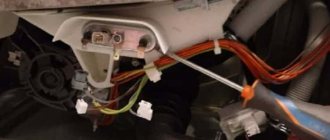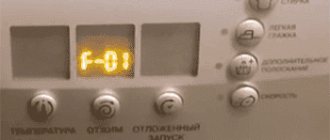Calculate cost Reviews Geography Contacts
Electrolux service center No. 1 in Moscow Post-warranty service and repair of Electrolux with home visits, seven days a week from 9:00 to 22:00
8 Call back
Poor spinning, when clothes remain wet after washing in the machine, is a common situation. But before looking for the technical source of the problem, you need to check that the drum is loaded correctly and the modes are set. Overload often occurs when using narrow models with a depth of 35-40 cm. These washing machines are designed for 5-6 kg, but users try to load them to the maximum. As a result, the clothes become bunched up and the ELECTROLUX washing machine stops spinning. You need to unload it and, if necessary, wring out heavy woolen items by hand.
Another common mistake is incorrect setting of modes. Some models have a “no spin” mode, in which the laundry remains in the water while the owners are away. If this mode exists, then it can be installed inadvertently. Spin is also not provided for delicate washing, so that things do not stretch or tear. If the ELECTROLUX washing machine allows you to adjust the speed per minute, it is possible that the speed is set to low and the laundry is not being spun. When checking the modes and speeds does not reveal their incorrect setting, it means there is a malfunction in the machine itself.
What's broken if it doesn't spin clothes?
- Drain pump (pump). If the spin mode works normally, but the water does not go down the drain and the laundry remains wet, then the pump is damaged. A “smacking” sound may appear. This is the most common breakdown in budget ELECTROLUX washing machines, since they do not have a filter installed in front of the pump. Because of this, any foreign object can damage the pump. The problem is solved by replacing it.
- Water level sensor (pressostat). The sensor also fails quite often. This device sends information about the water level to the control board, based on which the spin cycle is started or not. If the sensor is damaged, the board simply does not receive information. Most manufacturers provide their own error codes for the sensor.
- Tachometer (Hall sensor). This is an RPM control device that may cause your ELECTROLUX washing machine to not reach the required speed or spin. It breaks down infrequently, but some manufacturers also provide error codes when it breaks down.
- Electronic module or motor. The most complex and expensive breakdowns occur with washing machines. In the case of the control board, the stabilizer fails and the system does not start the spin mode. Long-term use may result in brush wear, breakage or short circuit of the motor winding. In case of these malfunctions, the technicians, accordingly, carry out flashing the board or replacing the motor.
Diagnostics of the Electrolux automatic washing machine
Modern washing machines are equipped with a self-diagnosis function . If individual systems of the device are faulty, then during an automatic test the computer records deviations from the norm and displays an error code on the display.
To clarify the cause of the breakdown, it may be necessary to disassemble the MCA and check the parts with a multimeter.
Electrolux machines have a diagnostic (service) mode, which can be entered by holding down the start button and the one next to it, and then turning on all the washing modes one by one.
| Type of failure | Signs | Error code | What is needed for diagnosis |
| Drive belt problems | The machine does not rotate the drum or cannot reach high speeds, which reduces the spin quality | EA31-EA6 | Remove the back panel, inspect the belt, rotate the drum |
| Drain pump failure | The spin cycle does not start; there is water in the tank. The pump does not buzz at the end of the rinse program | E21, EF1, EF3 | Remove the drain filter and pump, inspect the impeller, check the resistance of the pump |
| Clogged drain system | The pump hums, but does not drain water, spinning is impossible | From E20 to E24, EF1 | Inspect the drain pipe, filter and sewer system |
| Bearing wear | The drum does not rotate. There may be visible streaks of rust on the tank. With non-critical wear, the SMA erases and wrings out, but is very noisy | In some cases - E50 | Remove the back panel, inspect the tank, check the drum for jamming |
| Problems with the pressure switch | The water remains inside the tank, although the hum of the pump can be heard. SMA does not switch to the spin program | From E31 to E35, E38, E39 | Remove the pump and pressure switch, check the condition of the hose and the sensor resistance |
| Incorrect operation of the tachometer | Spin is weak or absent | E52 | Remove the motor, check the condition and resistance of the winding. The tachometer is examined simultaneously with the engine |
| Damage to the engine, tachogenerator | There is no rotation, you can’t hear the motor running | E50-E59 | |
| Motor brush wear | The drum does not rotate. If the brushes are worn uncritically, the SMA presses out, but cannot reach high speeds | E50, E52 | Remove and disassemble the engine |
| Malfunctions of the electronic module | Depends on the nature of the malfunction | From E53 to E56, E24, E98, etc. | Disassemble the SMA, inspect the contacts for breaks and check the condition of the board tracks |
| Overload, imbalance of laundry | Spin stops immediately after it starts | EF5 | Place the machine on a flat surface and check the weight of the loaded laundry. |
| Damage to shock absorbers | There is no spin, although the wash and rinse programs are turned on | — | Remove the top cover of the SMA, press on the tank. If the shock absorbers do not dampen vibrations, then remove the rear panel and inspect their condition. |
How to determine a fault code without a display?
Some SMA models are not equipped with a display. In this case, error codes can be recognized by the blinking or lighting of the indicators. The method for determining a malfunction depends on the type of electronic module:
- EWM1000 . The error number is transmitted by two indicators located near the “Start” button. The number of flashes of the first light indicates the first digit of the code, and the second - the last.
- EWM2000 . To determine the error code, the new generation ECU uses an indicator system located on the right side of the dashboard. The first digit is determined by the numbers of the light bulbs in the top row, and the second - in the bottom.
Low prices
| Service | Price |
| Diagnostics | |
| When ordering repairs | For free |
| In case of refusal of repair | 1 standard hour |
| Full product diagnostics (functionality check) | 2 standard hours |
| Major renovation | |
| Replacing the electric motor | 1.5 standard hours |
| Replacing the drum pulley | 2 standard hours |
| Replacing shock absorbers without removing the tank | 1.4 standard hours |
| Replacing the electrical harness | 2.2 standard hours |
| Replacement of supports, crosses | 2.2 standard hours |
| Replacement of drum, tank | 2.5 standard hours |
| Replacing bearings | 2.5 standard hours |
| Installation of counterweights | 1.3 standard hours |
| Replacement of housing elements | 2 standard hours |
| Repair of medium complexity | |
| Sealing or replacing pipes | 1 standard hour |
| Replacing the drain pump | 1.2 standard hours |
| Removing clogged drain pumps and hard-to-reach pipes | 1.2 standard hours |
| Replacing the solenoid valve | 1.5 standard hours |
| Replacing the heating element | 1.5 standard hours |
| Replacing the pressure switch | 1.2 standard hour |
| Replacing the level sensor | 1.1 standard hours |
| Replacing the display unit, electronic module | 1.7 standard hour |
| Replacement (installation and dismantling) of KSMA | 1 standard hour |
| Electrical circuit repair | 2 standard hours |
| Configuration (firmware) of the electronic unit | 2 standard hours |
| Replacement of signal lamps of the dispenser, front panel | 1 standard hour |
| Belt replacement | 1.1 standard hours |
| Cleaning the dryer | 1.5 standard hours |
| Replacing the drying heating element | 1.5 standard hours |
| Replacing the thermostat, drying timer, suspension springs, hatch lock | 1.5 standard hours |
| Closing the drum curtains | 2.5 standard hours |
| Removing foreign objects from the tank | 1.6 standard hour |
| Minor repairs | |
| Removing the transport fasteners | 1 standard hour |
| Replacing the hook, hatch handle, hatch fastening, glass | 0.8 standard hours |
| Replacement of door seal, hatch cuff | 1.6 standard hours |
| Opening the loading hatch door | 1 standard hour |
| Replacement of the power button, capacitor, surge protector, power cord, repair of the KSMA indicator | 0.7 standard hours |
| Replacing the drain hose | 1.2 standard hours |
| Replacing the aquastop (hydrostop) | 1.2 standard hours |
| Minor repairs (without disassembling the machine) | 0.5 standard hours |
| Maintenance | 1 standard hour |
| Related | |
| Repair of units, modules | 50% of the price of new |
| Installation and dismantling of the built-in device | 1 standard hour |
| Cleaning the system | 1 standard hour |
| Markup coefficient | |
| Embedding | 1,8 |
| Premium model | 1,8 |
| Urgent departure (within 15 minutes) | 1,5 |
| Cramped working conditions | 1,5 |
| Any repairs involving complete disassembly of the product | 2,5 |
| Basic values | |
| Standard hour (rounded up to half an hour) | 1000 |
| Final provisions | |
| ● When repairing the control board, the technician takes the board, after the repair he returns it and installs it ● Spare parts and consumables are paid separately ● Travel outside the city - 40 rubles/km ● The final price of the repair is determined by the technician, based on the complexity of the breakdown and the volume of work performed | |
Repair
After determining the cause of the malfunction, you can begin to restore the SMA. To do this, it is necessary to disassemble the device and replace non-repairable parts.
Cleaning the drain system
If the SMA does not start spinning due to lack of drainage, then you need to check the filter and drain pipe for blockages. To do this you need:
- turn off the machine from the network;
- place a wide, low container under the right front side of the device;
- remove the front lower panel, behind which is the drain filter handle;
- turn and remove the part;
- drain the water, periodically pouring it out of the container;
- clean the filter and part slot;
- disconnect the drain pipe, check it for passability under running water;
- Reinstall the pipe and filter, turn on the drain program.
Replacing or restoring the drain pump
If the filter and pipe are not clogged, but water continues to stand in the tank, then the problem lies in the drain pump. This part is repairable only in 2 cases:
- If the impeller is jammed by a foreign object (without breaking the blades).
- If the contacts have come loose or oxidized.
In case of other malfunctions, the pump is replaced with a new one.
Drive belt
The belt is located on the back of the tank, so it can be easily changed independently. The tape is removed from the shaft and installed with similar characteristics.
If the belt falls off after replacement, it is necessary to check the condition of the bearings, crosspiece and springs.
We repair the engine
To repair the motor you may need:
- cleaning and restoration of contacts;
- replacing brushes;
- restoration of connections (wires, terminals);
- installing a new thermistor;
- replacing the stator winding.
If the rotor needs to be replaced or the broken parts of the motor are filled with compound (epoxy resin), then the engine is unsuitable for repair.
Bearings
To replace the bearings, as a rule, a technician is invited from the service center. In some cases, it may be necessary to transport the SMA to a workshop. Specialists disassemble the tank, install new bearings and seals, and then check the balance of the drum as it rotates.
Shock absorbers
To replace shock absorbers you must:
- Remove the top and back panels of the machine.
- Find and remove the mounting parts under the tank.
- Select spare parts with similar configurations.
- Install a new set and run the spin program to check.
In some SMA models, shock absorbers are located in such a way that replacing them requires complete disassembly of the tank. In this case, it is better to contact a professional.
Even if one shock absorber breaks down, these parts are replaced in pairs, otherwise the imbalance will lead to repeated destruction.
RPM sensor
The tachometer, or Hall sensor, rarely fails. As a rule, most problems are caused by loosening of its fasteners or poor contact with the computer.
To check and repair you need:
- remove the engine;
- inspect and clean the contacts (for example, with technical alcohol);
- tighten the sensor fastenings;
- Reinstall the motor and turn on the spin cycle.
If the problem persists and the engine is working properly, you will have to buy a new tachometer.
Pressostat
To repair the level sensor, you need to remove the top panel, find the round part and inspect its contacts. If the pressure switch is connected to the wiring, then:
- Disconnect the hose connected to the sensor and prepare a tube of the same diameter.
- Blow into the tube.
- If clicks are not heard when air is supplied, replace the pressure switch; in other cases, replace the damaged hose or clean the pressure sampling chamber.
Electronic module
To restore the ECU operation you may need:
- replace burnt radio elements (relays, capacitors, etc.);
- clean the board from oxides;
- solder burnt tracks;
- reprogram the module (to do this, memory is removed from it).
If the cause of the breakdown is a processor malfunction or extensive damage to the tracks, the entire electronic unit is replaced.
% discounts
| Types of jobs | Discount for master's work |
| Replacing one part | 10% |
| Replacing two parts | 20% |
| Replacing three parts | 30% |
| To whom | |
| WWII veterans | 50% |
| Low-income citizens | 20% |
| Large families | 20% |
| Single mothers | 20% |
| Pensioners | 20% |
| Disabled people of the 1st group | 20% |
| For students | 10% |
Cost of calling a technician
Depending on the cause of the breakdown, the cost of repairing the AMS is:
- engine - from 1600-2300 rubles;
- drive belt - from 1000 rubles;
- shock absorbers - from 2500 rubles;
- sensors - from 1800 rubles;
- drain pump - from 1800 rubles;
- control unit - from 2300-2900 rubles;
- bearings - from 3800 rub.
The cost of repairs does not include the price of spare parts that will be required for replacement. In addition to the nature of the malfunction, the price is affected by the model of the device and the complexity of the work.
For example, repairing an ECU may cost more than replacing a complete module. But considering the price of the part itself, installing a new board will cost more. If repairs are needed urgently, and diagnostics require transportation to a service center, then the cost may increase.
How to avoid becoming a victim of scammers?
To avoid being deceived by unscrupulous craftsmen, you must:
- Check the location of the office at the address indicated in the directories.
- Study reviews and pay attention to the dates of writing (paid reviews have template wording and are posted in one period).
- Specify the cost and diagnostic conditions in advance.
The master must provide an estimate, a certificate of completion of work, a receipt and receipts for the purchase of spare parts. Reliable service centers provide a guarantee for repairs. Depending on the nature of the breakdown, its period ranges from 6 months to 2 years.
Testing the engine
What does this code indicate? Error E02 indicates a malfunction of the CMA motor or control board. Most Electroluxes have a collector motor, which you can check yourself.
What to do before testing the motor? Initially, you need to understand the motor connection diagram. Most collector engines have a fairly simple design.
In Electrolux washing machines, a relay is used to switch the stator winding, and control device contacts are used. The described components are located in the control module of the washing machine.
The stator winding is divided into 2 sections. This design feature reduces the influence of interference that periodically occurs due to the appearance of sparks on the collector.
The drum of any washing machine rotates alternately in different directions. This movement is caused by a change in the polarity of the stator winding. Some models have a separate outlet for winding; it is activated when spinning things. In this case, the electric current is connected to any of the outer terminals and this outlet. At the stage of the main washing process, the stator winding is switched on through the outer terminals, this ensures a leisurely, smooth rotation of the drum.
To check the engine and find a solution to the problem, it is necessary to connect the rotor and stator windings alternately and turn them on to the electrical network. This connection diagram is visually presented as follows:
This diagnostic method has some disadvantages. Firstly, by choosing this testing method, you will not have the opportunity to ensure that the motor is 100% in working order. Regular rotation of the shaft cannot guarantee that the Electrolux machine will not fail at various stages of washing.
In addition, connecting elements according to this scheme does not provide protection. Therefore, if during testing the engine becomes short, it will most likely simply fail. To protect the electric motor from possible damage, it is better to include an additional link in the circuit. As an additional element, you can use the heating element of a washing machine or simply a high-power lamp (more than 500 W). The diagram will look like this:
The ballast included in the connection will protect the engine being tested. If a short circuit occurs, the current will flow to the heating element, which will begin to heat up.
There is another way to diagnose the motor in an Electrolux washing machine. The stator and rotor windings are connected similarly to the second circuit, only they are powered by a special laboratory transformer with a power of over 500 W. The advantage of the method is the ability to constantly monitor the speed and take timely measures in case of any failure. For greater safety, it is permissible to use a fuse with a capacity of 5-10 Amps.
Instead of an autotransformer, it is allowed to use an electronic regulator for diagnostics, which is usually used to control loads of a given power. In this case, it is better to seek help from specialists, but if you have some knowledge of electronics, you can carry out diagnostics and repairs yourself.
Another option for checking the motor is to observe how strong and bright the sparking between the brushes and the commutator motor is. If there is significant sparking, the washer motor is likely faulty.
It is by the above methods that it is possible to check the electric motor of an automatic machine that displays error E02
If, after diagnosing the engine, you cannot find a solution to the problem, you should proceed to checking another important element of the system
Adviсe
If the warranty period has not expired, it would be more advisable to contact a service center for help. This should be done immediately, without attempting self-diagnosis and repair. The fact is that warranty service does not accept electronics that have already been repaired.
Problems with spinning can be prevented if you pay attention to malfunctions in the washing machine in a timely manner. The following “symptoms” indicate that there is some kind of problem:
- after finishing washing and spinning, the laundry is still too wet;
- during the washing process, the unit produces extraneous noise: humming, tapping, etc.;
- the water suddenly began to drain slower than usual.
Don't forget about prevention. After each wash, you need to carry out several manipulations with the machine. First, wash the detergent dispenser tray. Secondly, blot the rubber seal on the hatch with a dry rag and clear it of debris. Third, dry the drum by leaving the car door open for several hours.
To care for your washing machine, you should choose the right household chemicals. Use only cleaning products that are specifically designed for this type of household appliance.
Electrolux fault codes
The self-diagnosis system allows the user to determine the cause of the malfunction. When the fault code is displayed on the display, you just have to find out its meaning. Then troubleshooting will be quick.
Let's look at the main Electrolux error codes:
| Error code | Code meaning |
| E11 | No water supply. |
| E13 | There is a water leak. |
| E21 | Error draining water. |
| E23/E24 | There is a problem with the board's triac, which is responsible for the operation of the pump. |
| E31/E32 | Pressostat failure. |
| E33 | The heating element does not work. |
| E35 | Overflow of water. Exceeding the normal level. |
| E36 | The heater protection sensor has failed. |
| E38 | There is a problem with the pressure switch. |
| E39 | The overflow sensor is faulty. |
| E41/E45 | Broken mechanical lock, UBL, door handle. |
| E51/E54 | Problems with the control module. |
| E55 | The SM motor or its wiring is faulty. |
| E56 | Tachogenerator failure. |
| E57 | The voltage in the circuit exceeds the permissible limits. |
| E58/E59 | Error in the operation of the electric motor. |
| E5A/E5E | Control module error. |
| E61/E62 | The water gets too hot. |
| E66 | Problems in the operation of the heating element. |
| E71 | Problems with the thermostat. |
| E72/E73 | Damage to the drying temperature sensor. KZ. |
| E74 | The thermistor is not positioned correctly. |
| E82/E84 | Main module malfunction. |
| E85 | Pump problem. |
| E91 | There is no communication with the control module. Wiring fault. |
| E92/E99 | Error in the control board. |
| EA1/EA6 | The DSP has failed. Worn drive belt. |
| EB1/EB3 | Problems with wiring. Incorrect voltage. |
| EF1 | The water did not drain after the timeout expired. |
| EF2 | Too much foam. |
| EF3 | Problems with the pump. |
| EF4 | The flow sensor does not give a signal. |
| EF5 | Drum overload. Stopping the operation of the SM. |
| EN1 | Power failure. Problems with the electronic board. |
| EN3 | Insufficient voltage in the network. |
| ENE | The circuit protection relay has broken. |
| ENF | Circuit relay not recognized. |
Possible user errors
If you are faced with the fact that your machine has stopped working for push-ups, then first you need to eliminate the possibility of user errors - that is, make sure that the unit has really failed.
The fact is that such errors are often caused by operational shortcomings, which can be easily and simply corrected. So, among the most common reasons is the installation of the wrong mode. Some items - delicate linen, shoes or outerwear - can be washed in special programs without spinning. It is likely that you could accidentally turn on a reduced mode of operation of your washing equipment instead of a full one. The cause of the error may be reloading the tank - in this case, the spin option simply cannot cope with such a load of laundry. At increased speeds due to malfunctions of the motor, the sensor simply blocks the rotation of the drum. The maximum weight that the SMA can handle is always indicated in the instructions - be sure to read this point before using the machine.
Laundry was folded incorrectly
As a rule, modern models of washing machines have an overload detection function (this is a situation when the weight of the laundry is too large and the machine cannot cope with the load). If your machine does not have such a mode, trouble occurs.
- The laundry is washed without any visible problems.
- When the spin starts, the machine tries to spin the drum, but this does not happen due to the heavy weight of the laundry.
- Attempts are repeated several more times.
- If the drum does not start rotating, the washing machine stops working, and you end up with wet laundry on your hands.
If the spin does not work precisely for this reason, at the end of the wash you should try to take out the laundry and spread it evenly over the drum. This will prevent the laundry from forming a heavy lump and reduce the load on the drum.
The control module has failed
The control module is the command center of the washing machine. All signals pass through it, after processing which the necessary commands are sent to other parts of the machine. If you have checked the mode, the weight of the laundry, the water in the tank, the tachometer and the engine, the only option left is with the module. Unfortunately, you won’t be able to check it yourself, let alone repair the module - you’ll have to call a technician.
Next, we will consider situations when the spin works, but there are “minor troubles.” If you hear extraneous knocking noises while spinning or washing clothes, most likely there are foreign objects in the space between the tub and the drum. To correct the situation, it is necessary to remove the heating element and remove foreign objects. Although the situation, as a rule, does not affect the quality of washing or spinning, you should not delay it: foreign things in the machine can lead to its complete malfunction.
Also, extraneous sounds in the washing machine may indicate wear of the bearings. In this case, disassemble the car and check if they are leaking. If any of the problems cannot be solved on your own, do not worry, not everything can be solved without special tools and knowledge. Just contact a specialist - even if it hits your wallet a little, it will help you save both time and nerves.
Source
Malfunctions due to user errors
Spinning clothes in a Bosch washing machine, as a rule, does not occur in cases where the owner makes a mistake in the process of selecting a program or violates the rules for using the equipment.
It should be noted that delicate washing modes either do not contain spinning at all, or they are performed at minimum speed.
Also, the user may inadvertently set the spin speed of the washing equipment incorrectly or turn it off completely.
In this case there is no problem. You must wait until the washing program has completed, and then spin the laundry separately. On Bosch machines this function is indicated by a spiral icon.
There is another reason - the mass of laundry loaded into the drum does not correspond to the maximum permissible load of the drum, as well as its volume. The machine drum should not be underloaded or overloaded.
You need to be very careful when sorting dirty laundry. After all, dirty things need to be sorted by quantity, color and weight.
For example, small items need to be complemented by some large item.
Choose a different mode
If you find that your laundry remains wet after washing, do not rush to call a professional. The most common and common reason that the machine does not spin is the use of a program in which spinning is not used. Such programs can be:
- wool washing;
- washing silk;
- gentle wash.
To make sure that this is the case, use the instructions for the machine (if you don’t have it on hand, find it on the Internet). If the mode you are using does not involve spinning, simply run it separately at the end of the wash. The advantage is that these problems are not related to technical faults and can be fixed without doing the repairs yourself or taking the car to a service center.
Also, the spin can be forcibly turned off even in the mode in which it is provided. Check that you are not faced with exactly this situation.
Preparing to disassemble the washing machine
To disassemble the Electrolux washing machine, you need to prepare the tools, and then disconnect the equipment from communications and electricity and move it to free space for more convenient work.
When disassembling, you should record every action on camera, especially removing the wiring. This will help you avoid making mistakes during assembly and prevent more serious equipment breakdowns that require expensive repairs.
If you need to purchase new parts, it is better to stay with original or similar ones, but not inferior in quality. The selection and purchase of parts should be carried out strictly in accordance with the model and brand of the Electrolux washing machine.
The peculiarity of the Electrolux washing machine is that its body is assembled from two halves: front and rear, connected by screws under the top cover. To carry out repairs, in most cases it is enough to remove the rear part of the case.
The disassembly process is as follows:
- Unscrew the two screws, slide and remove the top protective cover.
- On the left side, you need to unscrew the two screws holding the back panel.
- Repeat on the right side.
- At the back of the bottom of the Electrolux machine there are two more screws that need to be removed.
- The next two screws are on the sides and are covered with plugs. It is necessary to remove the latter and unscrew the fasteners.
- Now the panel is fixed only by a plastic holder secured with two latches. It is necessary to unclench them and lift the holder. In some models it consists of two halves connected by a screw. You need to unscrew the fasteners, release the latches and remove the holder.
- You can now remove the back panel of the washing machine.
Having completed these steps, the user can begin to repair and replace components such as the tank, motor, shock absorbers, pump and pump, belt, drain hose, heating element, etc.
Removing the front panel is necessary to replace the bearings. The following steps must be followed:
Pull out the detergent tray and unscrew the screws underneath it. Remove control panel
It is held on by latches; you need to act very carefully so as not to damage them. You need to disconnect the wiring with caution and after photographing the connection in order to avoid errors during assembly. Open the hatch, pry and remove the clamp, tuck the cuff inside the drum. Remove the wiring and hose from the pressure switch, remove the fasteners, and disconnect the part. Remove the drive belt. Disconnect the wiring from the engine, remove the screws, and pull out the motor. Pull out the heating element by unscrewing the fasteners and disconnecting the wiring. Disconnect the drain pipe and then the hose, having first loosened the clamps. Remove counterweights. Remove shock absorbers. Remove the tank from the springs and pull it out of the machine body. To replace the bearings you need to disassemble the tank
To do this, unscrew the bolt and remove the pulley. After this, the fasteners securing the tank halves are removed. After the tank is disassembled, the drum is pulled out and work is done to replace the bearings
To replace the bearings you need to disassemble the tank. To do this, unscrew the bolt and remove the pulley. After this, the fasteners securing the tank halves are removed. After the tank is disassembled, the drum is pulled out and work is done to replace the bearings.
If the tank in the Electrolux washing machine is non-separable, it is cut with a hacksaw. Bolts are used to connect the halves back together. Before cutting, fasteners are selected and holes are drilled according to their diameter along the connecting seam of the tank.
Disassembly of vertical washing machines occurs as follows:
- Use a slotted screwdriver to pry up the control panel, pull it up and slide it back.
- Tilt it a little, take a photo of the wire connection, disconnect them, and move the panel to the side.
- Disconnect the remaining wires from the electronic board, unscrew the fasteners, and remove the board.
- Remove the fill valve by first disconnecting the hoses from the clamps and disconnecting the wires.
- Unscrew the fasteners and remove the side panels.
- The fasteners holding the front panel in place are now visible. You need to unscrew it, remove the cover and put it aside.
Now the user has access to all important components of the washing machine, including bearings. There is no need to disassemble the Electrolux vertical tank to troubleshoot the problem.
Pump problems
Often, pump malfunctions prevent the machine from starting or finishing washing. Depending on what kind of problem appeared with the water, you can determine whether the pump itself or the filter has broken down. Both the filter and the pump itself are quite easy to repair with your own hands. These malfunctions, as they say, are not worth a damn.
Many Electrolux car models have a self-cleaning pump. Washing machines with this element make people's lives easier. Of course, it makes sense to produce such washing machines, with such a pump, and buy them. The filter in them cannot break. The self-cleaning pump is a fairly durable part that should last approximately 3-5 years. The Electrolux EWS-1046, for example, has just such a pump installed.
After seeing the photo, it’s easy to fall in love with this beautiful front-loading washing machine. It is simple and perfect. Perhaps, only if vertical loading is more tempting or a different set of standard functions is needed, will there be a desire to buy something else. Electrolux washing machines EWS-1046 are a popular model. What to do if this pump breaks down? It cannot be repaired. You will have to buy a new self-cleaning one and replace it completely. Electrolux washing machines EWS-1046 are beautiful appliances, practical and convenient. After the self-cleaning pump is replaced, the machine will continue to work and will work for many years.
Repairing Electrolux EWS-1046 is no different from repairing EWS-1020, for example. All spare parts are on sale. But be sure, when buying a part, you should check with the seller: who the manufacturer is, whether it fits this model - read the instructions, if there are any, compare with the old part. It is better to repair these washing machines using spare parts from trusted suppliers - original or analogues. Some parts are suitable for Electrolux EWS-1020, but not for Electrolux EWS-1046. It doesn't hurt to be mindful. It is better to take your registration certificate with you.
Problems with compactor and drum
Strong vibration and movement of the machine during operation is a potentially dangerous situation. This is a massive piece of equipment that will cause a lot of trouble, despite the fact that it seems static. When vibration is strong, washing machines can move and even fall. Water pipes, parquet floors, and furniture are in danger if washing machines do not want to stand quietly in one place. The culprit is either an uneven floor, improper installation, or a drum bearing.
The bearings in Electrolux cars are of high quality and should certainly last at least 6-7 years. If time has passed, or the rubber has worn out due to operating conditions, fluid will leak from the drum and there will be strong vibration. Needs renovation. The drum may also become deformed. You cannot wash it in such a machine.
Self-repair is possible in this case. What does he mean? Nothing complicated. Repair in this case comes down to three simple steps:
- buy a seal;
- remove the old one;
- put a new one in its place.
This part is fixed securely using special latches. Taking a closer look at the car you can understand what's what. Often the information is in the instructions. So almost anyone can do it. The repair will be successful. The only “but” is physical stress. A certain level of physical fitness won't hurt. You can entrust the repair to a specialist, because he, of course, is better versed in this. The work will be done much faster.
If you wish, you can repair any household appliances yourself. All that is required is a love of mathematics, physics, chemistry, and mechanical engineering. A mathematical mind, perhaps. And, of course, a tool will come in handy. Repairs are inconceivable without a screwdriver.
Detailed description of error codes
If the machine is equipped with an LCD display, then the code is displayed on the screen.
- E10
– there is no water in the tank or little water is supplied:
In the vast majority of cases, the fault lies in the water pressure at the valve inlet. Unscrew the water supply hose and open the shut-off valve. A stream of water should “break out” of the hose.
Washing machines do not have a pump, the water flows by gravity, and if this is prevented by a clogged filter or weak pressure in the inlet hose, then the water will either not flow at all or it will be bad, which will not allow the powder to be washed off properly!
Or incorrect connection of the drain hose to the sewer pipe. Water constantly leaves the tank! The tip of the hose should be raised to a height of 60 - 100 cm from the level of the legs or freely led into a pipe of a larger diameter.
Often, the drain hose is embedded (to prevent odor) into the sewer pipe. There are two reasons for this defect:
— The hose fell to the floor while being displaced. — A siphon effect has arisen in the sewer system.
- E20
– Blockages, wear and breakdown of the pump:
Difficulty draining is diagnosed by examining the inside of the drum, because... the result is a filled pump and remaining water in the tank. Troubleshooting is achieved by cleaning the pump.
Displacement of the impeller occurs during natural wear, therefore, in accordance with the manufacturer’s recommendations, the spare part should be changed every 5-6 years.
In this case, it can touch the pump housing or the pump motor housing and jam. It is also possible to scroll it independently of its shaft.
No glues, cold welding, epoxy resin, dichloroethane, etc. Do not attach the impeller for more than a month.
Therefore, in this case, there is only one way out - replacing the entire mechanical part of the drain pump.
- E40
– Sunroof lock error:
The culprit for all this may be: the control triac on the module and the door lock itself. The figure shows the control diagram:
Use a multimeter to check.
Three wires go to the lock. We measure the resistance of wires 1, 2 and 3 on the control board connector. There should be no break between supply wires 1 and 3. Between 2 and 3 the circuit must be open.
If the lock is working properly, the triac on the board has probably “exploded”. As a rule, replacing it, the error disappears.
- E50
– Malfunctions in engine control:
- appears due to dampness or due to low mains voltage - short circuit of the control triac - E52 signal from the tachogenerator does not reach the board - “sticking” of one of the contact groups of the reverse relay (there are two in total) of the drive motor - the spring washer holding it is loose tachogenerator coil - wear of the drum bearing assembly.
- e60 and eb0
are different errors, but they are confused:
e60 - occurs even if the insulation of the heating element is partially damaged and a leakage current appears on the housing. We check for a break with a tester - the resistance is about 30 ohms.
If the device does not show anything, then there is a break in the “boiler” - it needs to be replaced. We also check the “short” on the body. We measure the resistance between each power terminal (one by one) and the grounding bolt. When the tester shows resistance, there is a short to the washing machine body.
eb0 - underestimated network voltage.
- E70
– NTC temperature sensor:
Check the heating element itself and, of course, the t sensor (it should ring, stable contact and no breakage).
- E90
– error related to electronics:
Check the connector contacts to see if the buttons are stuck, perhaps your machine is in a damp room! Wipe the contacts of the control board (there are two of them) with alcohol, wipe off the moisture and dry with a hairdryer.
An anecdote for snack:
If you need to move the washing machine, but you don’t have enough strength, put something heavy in it to wash, then when it spins, it will easily move to a new place on its own.
